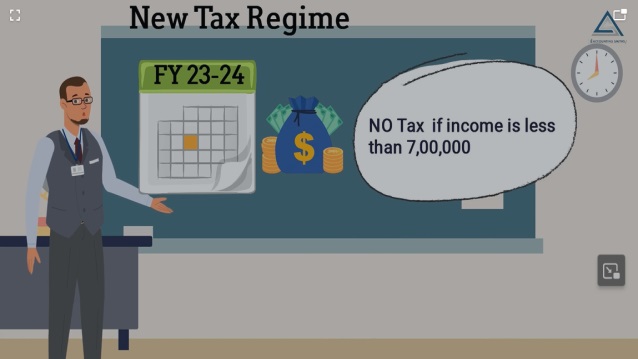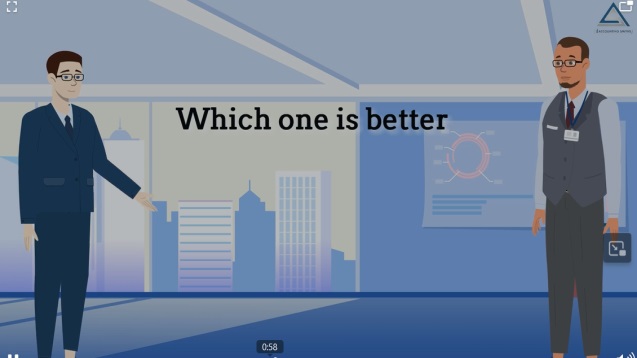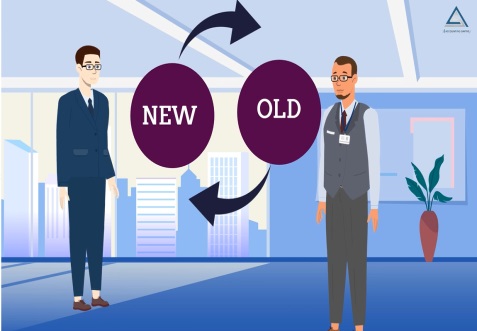With the help of this blog you will learn what exactly the new tax regime is, the comparison of old vs new tax regime among different factors like tax slabs, deductions and rebate available, practical examples of how the new regime will make a difference for each tax slab, and whether we can switch between old and new tax regimes.
What is New Tax Regime??

The New Regime was first launched in the Budget 2020. Since then, changes has been made to make it more attractive.
The government brought the New Regime to simplify taxes. For many, it becomes difficult to claim deductions and exemptions and maintain records. The government wants to ease all this compliance burden.
So Basically if you want your tax planning to be straightforward, New Regime will be the right choice.
But if you are among those who are fine with the compliances so that you can save maximum tax, you will need to thoroughly compare the two and then decide. So we are giving you the detailed comparison that can help you take a call on whether you should opt for the New Tax Regime or the Old one for in 2023
Detailed Comparison among New and Old Regime
Tax Slabs
In the new regime, the finance minister has increased the number of slab rates to six. Consequently, the tax rates are now 0%, 5%, 10%, 15%, 20%, and 30% in the six slabs while it is 0%,5%,20% and 30% under older regime.
Here is a comparison between the old and new tax slabs
| Tax Slabs Under New And Old Regime | |||
| Old Tax Regime | New Tax Regime | ||
| Tax Slab (₹) | Old Tax Rates | Tax Slab (₹) | New Tax Rates |
| 0 – 2.5 lakh | 0% | 0-3 lakh | 0% |
| 2.5 lakh – 5 lakh | 5% | 3 lakh – 6 lakh | 5% |
| 5 lakh – 10 lakh | 20% | 6 lakh-9 lakh | 10% |
| 10 lakh & above | 30% | 9 lakh-12 lakh | 15% |
| – | – | 12 lakh-15 lakh | 20% |
| – | – | 15 lakh & above | 30% |
Deductions available under both regime
The exemptions and deductions approx. more than 70 benefits including popular exemptions like HRA, LTA, 80C, 80D are available in the older regime but there are few available under the New Tax Regime like standard deduction of Rs 50,000. Here is the comparison of commonly used deductions in both regime..
| Commonly Used Deductions Comparison under both regime | ||
| Deductions | Old Tax Regime | New Tax Regime |
| Standard Deduction of 50,000 for employees | Allowed | Allowed |
| Deduction u/s 80 C { LIC, EPF, FD, Children Tuition Fees etc} upto 1,50,000 | Allowed | Not Allowed |
| Medical Insurance Premium-80 D | Allowed | Not Allowed |
| Donation to Political Party/Trust-80 G | Allowed | Not Allowed |
| Saving Banking Interest -80TTA & 80TTB | Allowed | Not Allowed |
| Employees Contribution to NPS | Allowed | Not Allowed |
| Employer Contribution to NPS | Allowed | Allowed |
| House Rent Allowance | Allowed | Not Allowed |
| Leave Travel Allowance | Allowed | Not Allowed |
| Interest on Home Loan u/s 24 b on self occupied vacant property | Allowed | Not Allowed |
| Interest on Home Loan u/s 24 b on let out property | Allowed | Allowed |
| Interest on Educational Loan-80E | Allowed | Not Allowed |
| Interest on Electric Vehicle Loan-80 EEB | Allowed | Not Allowed |
| Exemption on Gratuity u/s 10(10) | Allowed | Allowed |
| Exemption on Leave Encashment u/s 10(10AA) | Allowed | Allowed |
| Professional Tax | Allowed | Not Allowed |
Rebate
If the taxable income (after all deductions) under the old regime is below Rs 5 lakh, then the individual doesn’t need to pay any tax. Under the New Regime, the entire income will be tax-free if the taxable income is under Rs 7 lakh.
| Rebate under both regime | ||
| Rebate | Old Tax Regime | New Tax Regime |
| Rebate Amount | 12500 | 25000 |
Old Vs. New Tax Regime: Which One Should You Pick?

This decision to switch in between new or old tax regime depends on several factors like:-
Investment Goals- The new tax regime suits you if you are flexible with your investments and not looking forward to invest in tax-saving instruments. However, If you have investment goals such as saving for your retirement or building a capital for a long-term goal, the old tax regime may be more beneficial as it offers deductions for contributions to various investment instruments.
Simplicity- The new tax regime documentation process is simple, it eliminates the need to calculate and claim deductions and exemptions, which helps taxpayers to file the ITR quickly.
Income level- Under the new tax regime, the tax rates are lower than the old tax regime. The new tax regime may be more beneficial if you have a higher income. As per budget 2023, an individual with INR 9 lakh annual income will have to pay INR 45,000 as tax, which is 5% of the taxable income. This represents a reduction of INR 47,500 from the INR 92,500 tax liability that the same individual would have had under the old tax regime.
Similarly, an individual with INR 15 lakh annual income will have to pay a tax of INR 1.5 lakh under the new tax rates introduced under budget 2023 for the new tax regime, which is a reduction from the earlier tax liability of INR 1.87 lakh calculated as per new tax regime rates before budget 2023. The reduction in tax liability is due to the lower tax rates under the new tax regime, which has revised tax slabs and rates to relieve taxpayers.
Deductions and exemptions- Under the old tax regime, you can avail of a deduction of Rs 1.5 lakh under Section 80C and Rs 2 lakh under Section 24(b) on the interest amount for self-occupied property. This means a straight deduction of Rs. 3.5 lakh can be availed under the old tax regime, while the new tax regime does not offer such deductions and exemptions.
Unfortunately, there is no straight forward answer. The culprit is the complexity of the Indian tax regulations.
Let’s take three examples or scenarios to see how deductions and exemptions, or lack thereof, will impact taxes under the New Tax Regime and the Old one.
Scenario 1: When You Don’t Claim Any Deduction Or Exemption
In this scenario, we compare the two regimes assuming that the individual does not claim any deduction in both.
Assume Akshay is an employee who works as an doctor and has an income of Rs 9 lakh. Unfortunately, due to his education expenditure and family obligations, he is unable to avail deductions available under the old tax regime. So under the old tax regime, his tax liability comes out to be Rs 85,800.
This is how the calculations work for Sumit.
Taxable income: Rs 9,00,000 – Rs 50,000 (Standard Deduction) = Rs 8,50,000
| Income Tax Calculation Under Old Tax Regime | ||
| Tax Slabs Under Old Tax Regime | Tax Rate | Amount (₹) |
| Taxable Income | Rs. 8,50,000 | |
| 0 – 2,50,000 | 0% | NA |
| 2,50,000 – 5,00,000 | 5% | 12,500 (5% *2,50,000) |
| 5,00,000 – 10,00,000 | 20% | 70,000 (20% * 3,50,000) |
| 10,00,000 & above | 30% | NA |
| Total Tax | 82,500 | |
| Cess @ 4% | 3,300 | |
| Total Tax Inclusive Of Cess | 85,800 | |
So, the tax outgo on Rs 8,50,000 will be Rs 85,800. If Akshay chooses the new tax regime, his total tax outgo will be Rs 44,200
To help you avoid the above calculations, we have provided the tax liability under both regimes at different income levels in the table below. When you don’t avail deductions, the New Tax Regime works out to be better.
| Tax Paid Under Old And New Tax Regime for FY 2023-24 (in ₹) | |||
| Income | Old Regime | New Regime | Savings Under New Regime |
| 6,00,000 | 23,400 | 0 | 23,400 |
| 7,00,000 | 44,200 | 0 | 44,200 |
| 8,00,000 | 65,000 | 31,200 | 33,800 |
| 9,00,000 | 85,800 | 41,600 | 44,200 |
| 10,00,000 | 1,06,600 | 54,600 | 52,000 |
| 11,00,000 | 1,32,600 | 70,200 | 62,400 |
| 12,00,000 | 1,63,800 | 85,800 | 78,000 |
| 13,00,000 | 1,95,000 | 1,04,000 | 91,000 |
| 14,00,000 | 2,26,200 | 1,24,800 | 1,01,400 |
| 15,00,000 | 2,57,400 | 1,45,600 | 1,11,800 |
| 16,00,000 | 2,88,600 | 171600 | 117000 |
Scenario 2: When Deduction Under Section 80C & 80D is Claimed
In this scenario, we consider that the taxpayer takes Rs 1,50,000 and Rs 50,000 benefits under sections 80C and 80D, respectively. So, if you include the standard deduction of Rs 50,000, the taxpayer gets a total deduction of Rs 2.5 lakh.
If your income is below Rs 9 lakh, then the old tax regime is beneficial as you are saving smore tax. As your income increases, you save more tax with the new regime.
| Tax Paid Under Old And New Tax Regime for FY 2023-24 (in ₹) | |||
| Income | Old Regime | New Regime | Savings Under New Regime |
| 6,00,000 | 0 | 0 | 0 |
| 7,00,000 | 0 | 0 | 0 |
| 8,00,000 | 23,400 | 31,200 | -7,800 |
| 9,00,000 | 44,200 | 41,600 | 2,600 |
| 10,00,000 | 65,000 | 54,600 | 10,400 |
| 11,00,000 | 85,800 | 70,200 | 15,600 |
| 12,00,000 | 1,06,600 | 85,800 | 20,800 |
| 13,00,000 | 1,32,600 | 1,04,000 | 28,600 |
| 14,00,000 | 1,63,800 | 1,24,800 | 39,000 |
| 15,00,000 | 1,95,000 | 1,45,600 | 49,400 |
| 16,00,000 | 2,26,200 | 171600 | 54600 |
Scenario 3: When Taxpayer Claims Deduction Under Section 80C, For NPS Investments, Interest On Home Loan And Health Insurance Premium
In this scenario, we have considered employees who claim deductions not only from their investments under section 80C and 80CCD (1B) worth Rs 2 lakh but also claim a deduction for interest paid on home loans (Rs 2 lakh) and health Insurance premiums (Rs 25,000).
Someone who can claim all the above deductions is better off with the old tax regime.
| Tax Paid Under Old And New Tax Regime for FY 2023-24 (in ₹) | |||
| Income | Old Regime | New Regime | Savings Under New Regime |
| 6,00,000 | 0 | 0 | 0 |
| 7,00,000 | 0 | 0 | 0 |
| 8,00,000 | 0 | 31,200 | -31,200 |
| 9,00,000 | 0 | 41,600 | -41,600 |
| 10,00,000 | 18,200 | 54,600 | -36,400 |
| 11,00,000 | 39,000 | 70,200 | -31,200 |
| 12,00,000 | 59,800 | 85,800 | -26,000 |
| 13,00,000 | 80,600 | 1,04,000 | -23,400 |
| 14,00,000 | 1,01,400 | 1,24,800 | -23,400 |
| 15,00,000 | 1,24,800 | 1,45,600 | -20,800 |
| 16,00,000 | 1,56,000 | 171600 | -15600 |
Can we switch between Old and New Tax Regime?

In Union Budget 2023, the new tax regime was made the default regime. This implies that if you don’t explicitly choose between the old and new tax regimes, your taxes will automatically be calculated under the new regime. However, you retain the flexibility to switch back to the old regime at any point before the due date for filing your tax return for the relevant assessment year. The frequency of switches permitted depends on your profession or specific criteria set forth by tax regulations.
| Nature of Income | Time of selection of option of old vs new regime |
| Income from Salary or any other head of income attracting TDS | A salaried individual can switch between the new and the old tax regime in every financial year. Even if you have opted for the new tax regime for TDS throughout the year, you still have the option to easily change your chosen tax regime while filing your ITR. |
| Income from Business and Profession | Any individual with an income from a business or profession is not eligible to switch regimes more than once. For instance, once you choose the new tax regime, you can only switch back to the old regime once in your lifetime. This switch requires filing Form 10-IE along with your ITR. If you haven’t already filed Form 10-IE by the original due date for filing your ITR, you cannot switch back to the old regime for that year. |
 Support
Support 


